Analysis of Tourism in Hong Kong: Stakeholders and Impact
VerifiedAdded on 2019/09/24
|11
|2811
|175
Report
AI Summary
This report provides a comprehensive analysis of the tourism industry in Hong Kong, focusing on the pivotal role of the Tourism Commission. It details the commission's vision, mission, functions, and organizational structure, highlighting its responsibilities in developing and promoting tourism, managing projects, and coordinating with stakeholders. The report identifies key stakeholders, including internal and external groups, and examines the impact of the commission's work on the local neighborhood, environment, economy, and culture. It explores specific tourism projects like the Hong Kong Wetland Park and the Aberdeen Tourism Project, illustrating stakeholder relationships and the social, cultural, and economic implications of tourism development. The analysis also discusses the challenges and advantages of utilizing historical buildings and emphasizes the importance of green tourism and heritage conservation in attracting visitors and boosting the industry's growth. This report underscores the tourism industry's significant contribution to Hong Kong's GDP, employment, and overall economic development, while also addressing potential negative impacts and the need for effective management and stakeholder engagement.
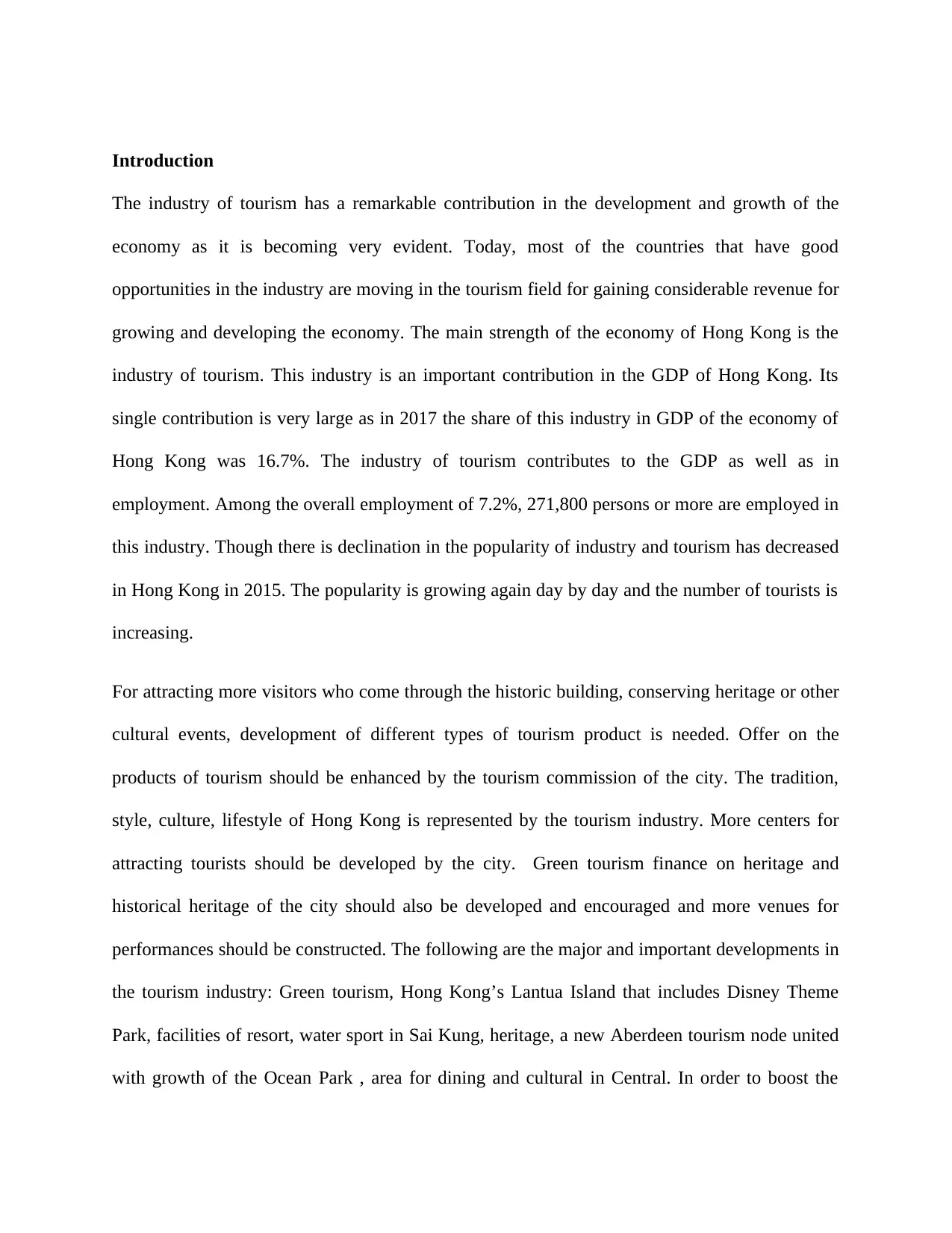
Introduction
The industry of tourism has a remarkable contribution in the development and growth of the
economy as it is becoming very evident. Today, most of the countries that have good
opportunities in the industry are moving in the tourism field for gaining considerable revenue for
growing and developing the economy. The main strength of the economy of Hong Kong is the
industry of tourism. This industry is an important contribution in the GDP of Hong Kong. Its
single contribution is very large as in 2017 the share of this industry in GDP of the economy of
Hong Kong was 16.7%. The industry of tourism contributes to the GDP as well as in
employment. Among the overall employment of 7.2%, 271,800 persons or more are employed in
this industry. Though there is declination in the popularity of industry and tourism has decreased
in Hong Kong in 2015. The popularity is growing again day by day and the number of tourists is
increasing.
For attracting more visitors who come through the historic building, conserving heritage or other
cultural events, development of different types of tourism product is needed. Offer on the
products of tourism should be enhanced by the tourism commission of the city. The tradition,
style, culture, lifestyle of Hong Kong is represented by the tourism industry. More centers for
attracting tourists should be developed by the city. Green tourism finance on heritage and
historical heritage of the city should also be developed and encouraged and more venues for
performances should be constructed. The following are the major and important developments in
the tourism industry: Green tourism, Hong Kong’s Lantua Island that includes Disney Theme
Park, facilities of resort, water sport in Sai Kung, heritage, a new Aberdeen tourism node united
with growth of the Ocean Park , area for dining and cultural in Central. In order to boost the
The industry of tourism has a remarkable contribution in the development and growth of the
economy as it is becoming very evident. Today, most of the countries that have good
opportunities in the industry are moving in the tourism field for gaining considerable revenue for
growing and developing the economy. The main strength of the economy of Hong Kong is the
industry of tourism. This industry is an important contribution in the GDP of Hong Kong. Its
single contribution is very large as in 2017 the share of this industry in GDP of the economy of
Hong Kong was 16.7%. The industry of tourism contributes to the GDP as well as in
employment. Among the overall employment of 7.2%, 271,800 persons or more are employed in
this industry. Though there is declination in the popularity of industry and tourism has decreased
in Hong Kong in 2015. The popularity is growing again day by day and the number of tourists is
increasing.
For attracting more visitors who come through the historic building, conserving heritage or other
cultural events, development of different types of tourism product is needed. Offer on the
products of tourism should be enhanced by the tourism commission of the city. The tradition,
style, culture, lifestyle of Hong Kong is represented by the tourism industry. More centers for
attracting tourists should be developed by the city. Green tourism finance on heritage and
historical heritage of the city should also be developed and encouraged and more venues for
performances should be constructed. The following are the major and important developments in
the tourism industry: Green tourism, Hong Kong’s Lantua Island that includes Disney Theme
Park, facilities of resort, water sport in Sai Kung, heritage, a new Aberdeen tourism node united
with growth of the Ocean Park , area for dining and cultural in Central. In order to boost the
Paraphrase This Document
Need a fresh take? Get an instant paraphrase of this document with our AI Paraphraser

industry of tourism in Hong Kong, a scheme of centralized and focused market should also be
devised by the tourism commission of the city. The standard of services provided determines the
favorable result of the industry. For enhancing the standard of services the, tourism commission
must focus on its quality. Developing tourism and conserving heritage has an intense relationship
between them. Tourists visit the sights of cultural heritage where the place is conserved. Visitors
who come to the place are attracted to the heritage that reveals the values, traditions, and cultures
of the places. Visitors won’t visit the place and they would be less attracted if the tourism
commission is unable to conserve the heritage place. The duties and responsibilities of the
tourism sector of Hong Kong have been highlighted in this study. Association of stakeholders
has also been focused in this study. Effect of work of tourism sector like impacts on economy,
social and culture and environment and challenges as well as advantages of utilizing the
historical building has also been included.
The Tourism Commission
For maintaining the position of the city as leading city of destination for the tourists in Asia, the
tourism commission has been established by the government of Special Administrative Region
of Hong Kong in 1999. The establishment of tourism commission was controlled by the
Commerce and Economic Development Bureau of Hong Kong. The work of the commission is
supporting the growth of the new events and attracting and improving the facilities of tourists for
making Hong Kong a premier spot for the visitors. Commissioner of tourism of Hong Kong is
the head of the tourism commission. The duties of the commissioner are to map out the strategy
for developing tourism and scheme proposed by the government.
devised by the tourism commission of the city. The standard of services provided determines the
favorable result of the industry. For enhancing the standard of services the, tourism commission
must focus on its quality. Developing tourism and conserving heritage has an intense relationship
between them. Tourists visit the sights of cultural heritage where the place is conserved. Visitors
who come to the place are attracted to the heritage that reveals the values, traditions, and cultures
of the places. Visitors won’t visit the place and they would be less attracted if the tourism
commission is unable to conserve the heritage place. The duties and responsibilities of the
tourism sector of Hong Kong have been highlighted in this study. Association of stakeholders
has also been focused in this study. Effect of work of tourism sector like impacts on economy,
social and culture and environment and challenges as well as advantages of utilizing the
historical building has also been included.
The Tourism Commission
For maintaining the position of the city as leading city of destination for the tourists in Asia, the
tourism commission has been established by the government of Special Administrative Region
of Hong Kong in 1999. The establishment of tourism commission was controlled by the
Commerce and Economic Development Bureau of Hong Kong. The work of the commission is
supporting the growth of the new events and attracting and improving the facilities of tourists for
making Hong Kong a premier spot for the visitors. Commissioner of tourism of Hong Kong is
the head of the tourism commission. The duties of the commissioner are to map out the strategy
for developing tourism and scheme proposed by the government.
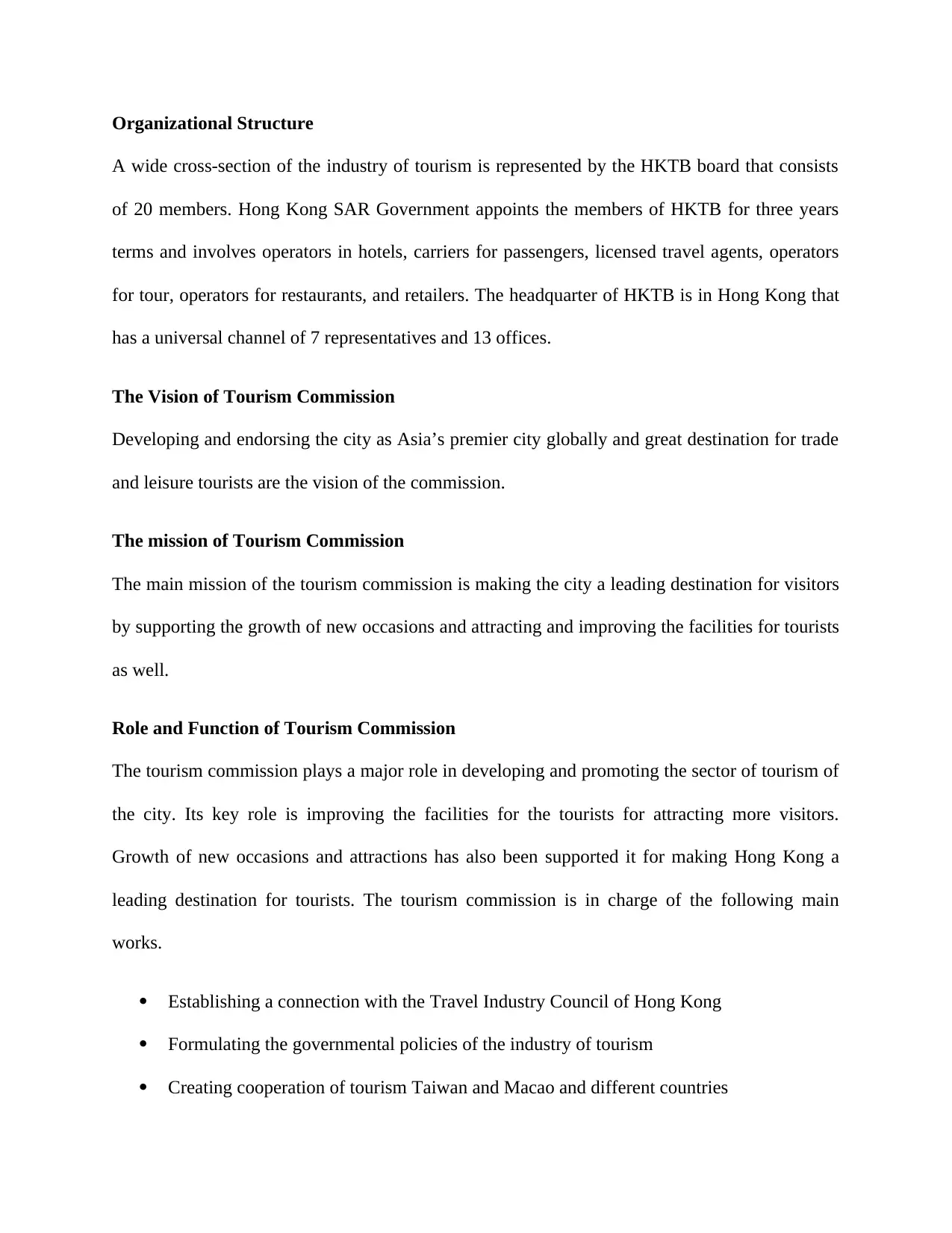
Organizational Structure
A wide cross-section of the industry of tourism is represented by the HKTB board that consists
of 20 members. Hong Kong SAR Government appoints the members of HKTB for three years
terms and involves operators in hotels, carriers for passengers, licensed travel agents, operators
for tour, operators for restaurants, and retailers. The headquarter of HKTB is in Hong Kong that
has a universal channel of 7 representatives and 13 offices.
The Vision of Tourism Commission
Developing and endorsing the city as Asia’s premier city globally and great destination for trade
and leisure tourists are the vision of the commission.
The mission of Tourism Commission
The main mission of the tourism commission is making the city a leading destination for visitors
by supporting the growth of new occasions and attracting and improving the facilities for tourists
as well.
Role and Function of Tourism Commission
The tourism commission plays a major role in developing and promoting the sector of tourism of
the city. Its key role is improving the facilities for the tourists for attracting more visitors.
Growth of new occasions and attractions has also been supported it for making Hong Kong a
leading destination for tourists. The tourism commission is in charge of the following main
works.
Establishing a connection with the Travel Industry Council of Hong Kong
Formulating the governmental policies of the industry of tourism
Creating cooperation of tourism Taiwan and Macao and different countries
A wide cross-section of the industry of tourism is represented by the HKTB board that consists
of 20 members. Hong Kong SAR Government appoints the members of HKTB for three years
terms and involves operators in hotels, carriers for passengers, licensed travel agents, operators
for tour, operators for restaurants, and retailers. The headquarter of HKTB is in Hong Kong that
has a universal channel of 7 representatives and 13 offices.
The Vision of Tourism Commission
Developing and endorsing the city as Asia’s premier city globally and great destination for trade
and leisure tourists are the vision of the commission.
The mission of Tourism Commission
The main mission of the tourism commission is making the city a leading destination for visitors
by supporting the growth of new occasions and attracting and improving the facilities for tourists
as well.
Role and Function of Tourism Commission
The tourism commission plays a major role in developing and promoting the sector of tourism of
the city. Its key role is improving the facilities for the tourists for attracting more visitors.
Growth of new occasions and attractions has also been supported it for making Hong Kong a
leading destination for tourists. The tourism commission is in charge of the following main
works.
Establishing a connection with the Travel Industry Council of Hong Kong
Formulating the governmental policies of the industry of tourism
Creating cooperation of tourism Taiwan and Macao and different countries
⊘ This is a preview!⊘
Do you want full access?
Subscribe today to unlock all pages.

Trusted by 1+ million students worldwide
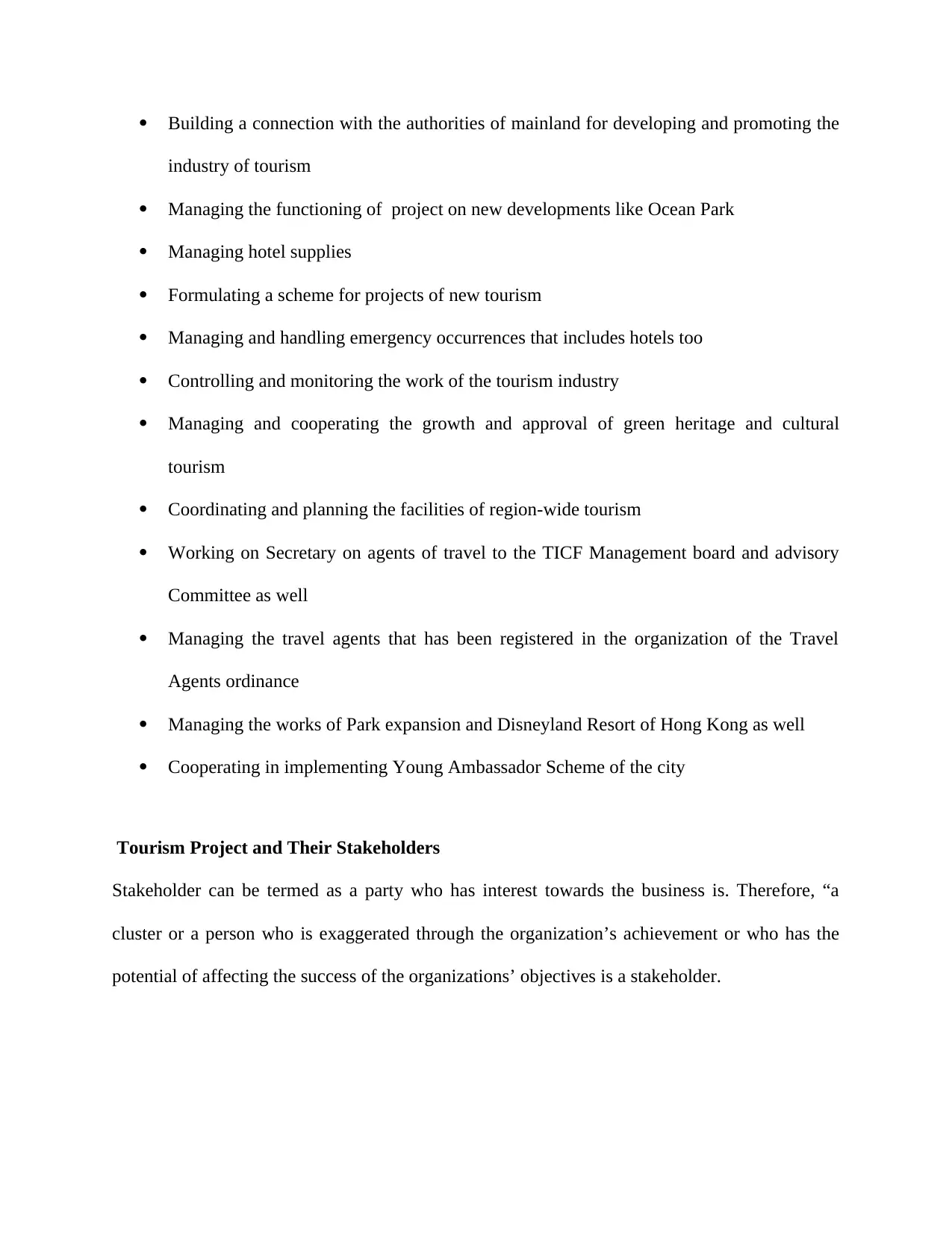
Building a connection with the authorities of mainland for developing and promoting the
industry of tourism
Managing the functioning of project on new developments like Ocean Park
Managing hotel supplies
Formulating a scheme for projects of new tourism
Managing and handling emergency occurrences that includes hotels too
Controlling and monitoring the work of the tourism industry
Managing and cooperating the growth and approval of green heritage and cultural
tourism
Coordinating and planning the facilities of region-wide tourism
Working on Secretary on agents of travel to the TICF Management board and advisory
Committee as well
Managing the travel agents that has been registered in the organization of the Travel
Agents ordinance
Managing the works of Park expansion and Disneyland Resort of Hong Kong as well
Cooperating in implementing Young Ambassador Scheme of the city
Tourism Project and Their Stakeholders
Stakeholder can be termed as a party who has interest towards the business is. Therefore, “a
cluster or a person who is exaggerated through the organization’s achievement or who has the
potential of affecting the success of the organizations’ objectives is a stakeholder.
industry of tourism
Managing the functioning of project on new developments like Ocean Park
Managing hotel supplies
Formulating a scheme for projects of new tourism
Managing and handling emergency occurrences that includes hotels too
Controlling and monitoring the work of the tourism industry
Managing and cooperating the growth and approval of green heritage and cultural
tourism
Coordinating and planning the facilities of region-wide tourism
Working on Secretary on agents of travel to the TICF Management board and advisory
Committee as well
Managing the travel agents that has been registered in the organization of the Travel
Agents ordinance
Managing the works of Park expansion and Disneyland Resort of Hong Kong as well
Cooperating in implementing Young Ambassador Scheme of the city
Tourism Project and Their Stakeholders
Stakeholder can be termed as a party who has interest towards the business is. Therefore, “a
cluster or a person who is exaggerated through the organization’s achievement or who has the
potential of affecting the success of the organizations’ objectives is a stakeholder.
Paraphrase This Document
Need a fresh take? Get an instant paraphrase of this document with our AI Paraphraser
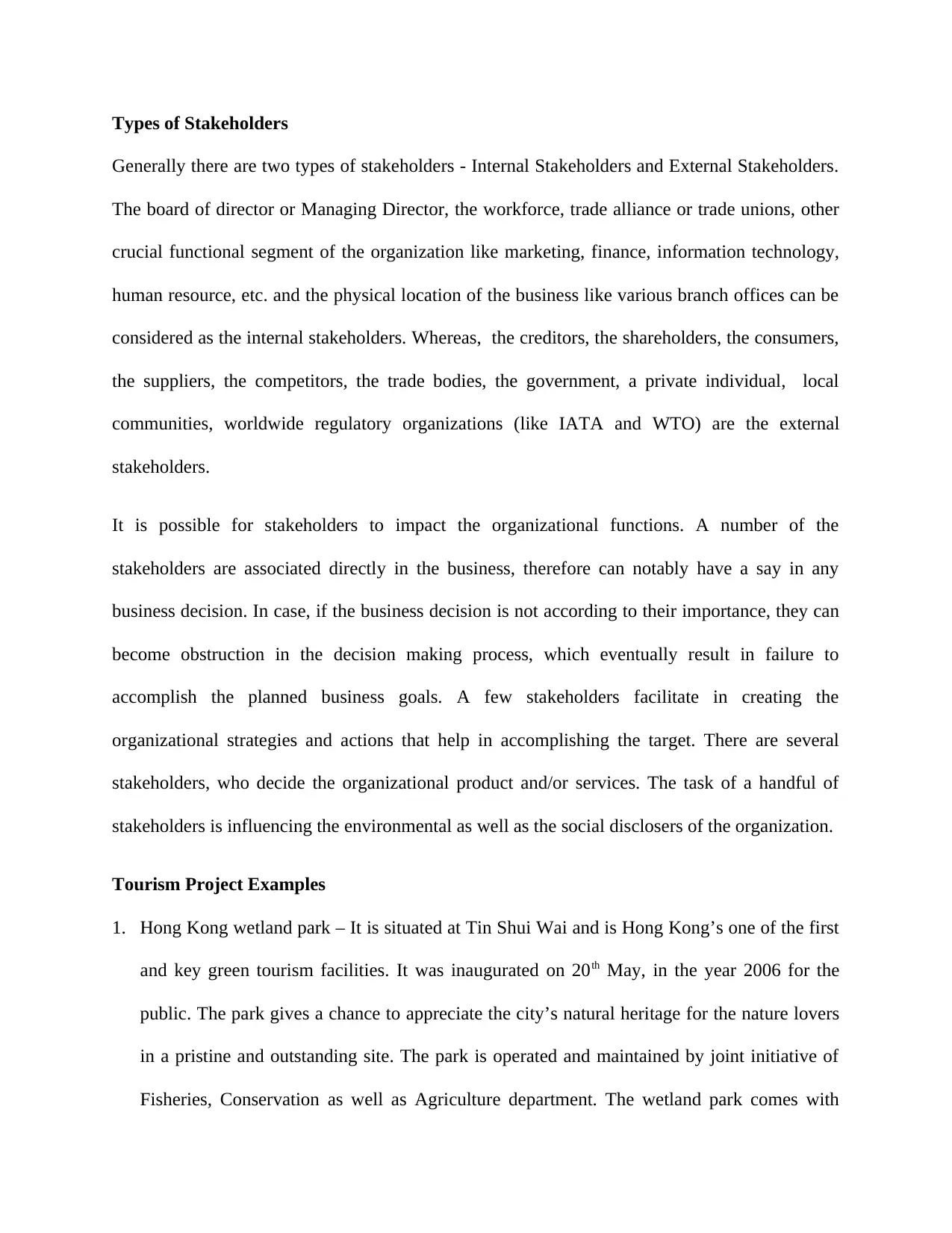
Types of Stakeholders
Generally there are two types of stakeholders - Internal Stakeholders and External Stakeholders.
The board of director or Managing Director, the workforce, trade alliance or trade unions, other
crucial functional segment of the organization like marketing, finance, information technology,
human resource, etc. and the physical location of the business like various branch offices can be
considered as the internal stakeholders. Whereas, the creditors, the shareholders, the consumers,
the suppliers, the competitors, the trade bodies, the government, a private individual, local
communities, worldwide regulatory organizations (like IATA and WTO) are the external
stakeholders.
It is possible for stakeholders to impact the organizational functions. A number of the
stakeholders are associated directly in the business, therefore can notably have a say in any
business decision. In case, if the business decision is not according to their importance, they can
become obstruction in the decision making process, which eventually result in failure to
accomplish the planned business goals. A few stakeholders facilitate in creating the
organizational strategies and actions that help in accomplishing the target. There are several
stakeholders, who decide the organizational product and/or services. The task of a handful of
stakeholders is influencing the environmental as well as the social disclosers of the organization.
Tourism Project Examples
1. Hong Kong wetland park – It is situated at Tin Shui Wai and is Hong Kong’s one of the first
and key green tourism facilities. It was inaugurated on 20th May, in the year 2006 for the
public. The park gives a chance to appreciate the city’s natural heritage for the nature lovers
in a pristine and outstanding site. The park is operated and maintained by joint initiative of
Fisheries, Conservation as well as Agriculture department. The wetland park comes with
Generally there are two types of stakeholders - Internal Stakeholders and External Stakeholders.
The board of director or Managing Director, the workforce, trade alliance or trade unions, other
crucial functional segment of the organization like marketing, finance, information technology,
human resource, etc. and the physical location of the business like various branch offices can be
considered as the internal stakeholders. Whereas, the creditors, the shareholders, the consumers,
the suppliers, the competitors, the trade bodies, the government, a private individual, local
communities, worldwide regulatory organizations (like IATA and WTO) are the external
stakeholders.
It is possible for stakeholders to impact the organizational functions. A number of the
stakeholders are associated directly in the business, therefore can notably have a say in any
business decision. In case, if the business decision is not according to their importance, they can
become obstruction in the decision making process, which eventually result in failure to
accomplish the planned business goals. A few stakeholders facilitate in creating the
organizational strategies and actions that help in accomplishing the target. There are several
stakeholders, who decide the organizational product and/or services. The task of a handful of
stakeholders is influencing the environmental as well as the social disclosers of the organization.
Tourism Project Examples
1. Hong Kong wetland park – It is situated at Tin Shui Wai and is Hong Kong’s one of the first
and key green tourism facilities. It was inaugurated on 20th May, in the year 2006 for the
public. The park gives a chance to appreciate the city’s natural heritage for the nature lovers
in a pristine and outstanding site. The park is operated and maintained by joint initiative of
Fisheries, Conservation as well as Agriculture department. The wetland park comes with
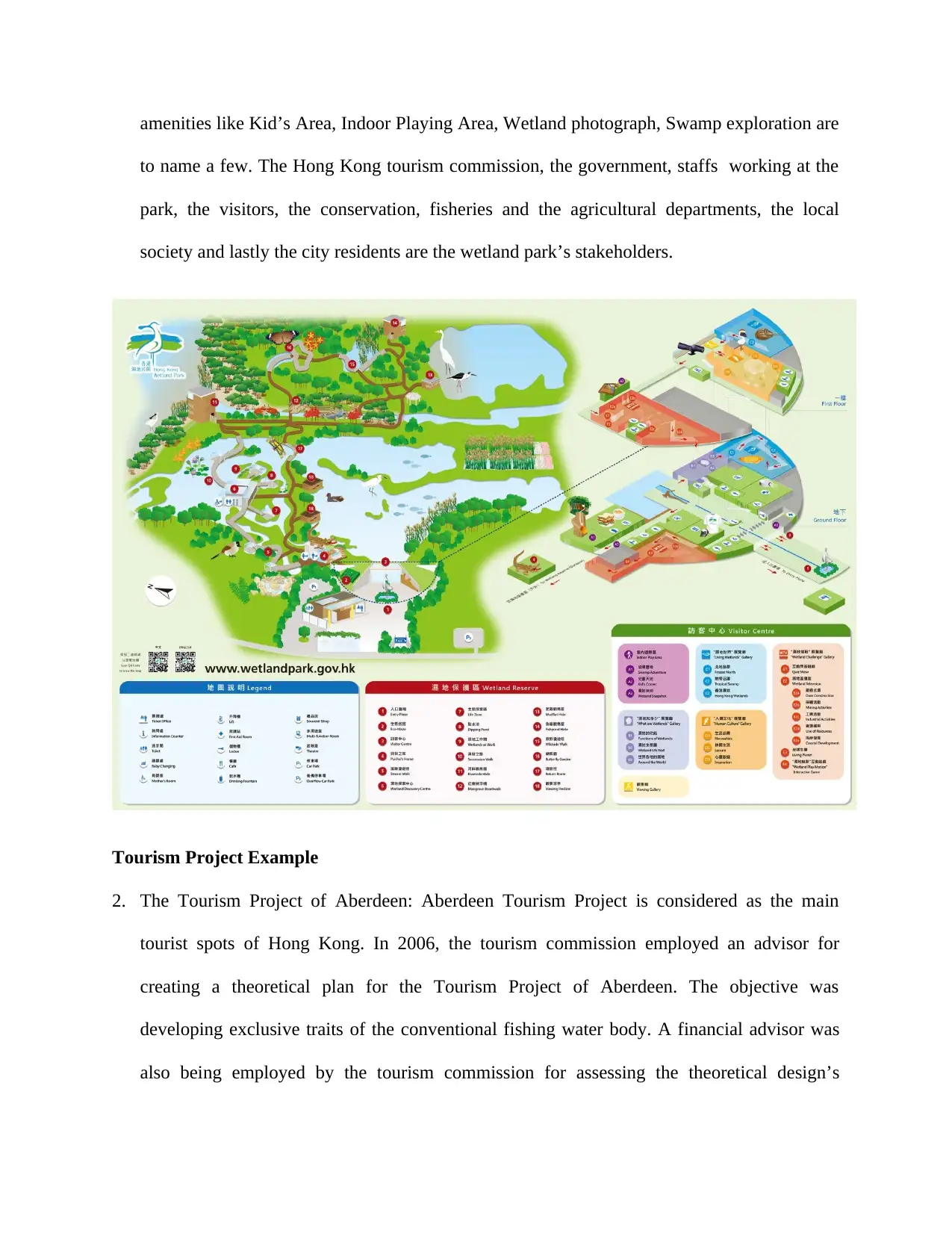
amenities like Kid’s Area, Indoor Playing Area, Wetland photograph, Swamp exploration are
to name a few. The Hong Kong tourism commission, the government, staffs working at the
park, the visitors, the conservation, fisheries and the agricultural departments, the local
society and lastly the city residents are the wetland park’s stakeholders.
Tourism Project Example
2. The Tourism Project of Aberdeen: Aberdeen Tourism Project is considered as the main
tourist spots of Hong Kong. In 2006, the tourism commission employed an advisor for
creating a theoretical plan for the Tourism Project of Aberdeen. The objective was
developing exclusive traits of the conventional fishing water body. A financial advisor was
also being employed by the tourism commission for assessing the theoretical design’s
to name a few. The Hong Kong tourism commission, the government, staffs working at the
park, the visitors, the conservation, fisheries and the agricultural departments, the local
society and lastly the city residents are the wetland park’s stakeholders.
Tourism Project Example
2. The Tourism Project of Aberdeen: Aberdeen Tourism Project is considered as the main
tourist spots of Hong Kong. In 2006, the tourism commission employed an advisor for
creating a theoretical plan for the Tourism Project of Aberdeen. The objective was
developing exclusive traits of the conventional fishing water body. A financial advisor was
also being employed by the tourism commission for assessing the theoretical design’s
⊘ This is a preview!⊘
Do you want full access?
Subscribe today to unlock all pages.

Trusted by 1+ million students worldwide
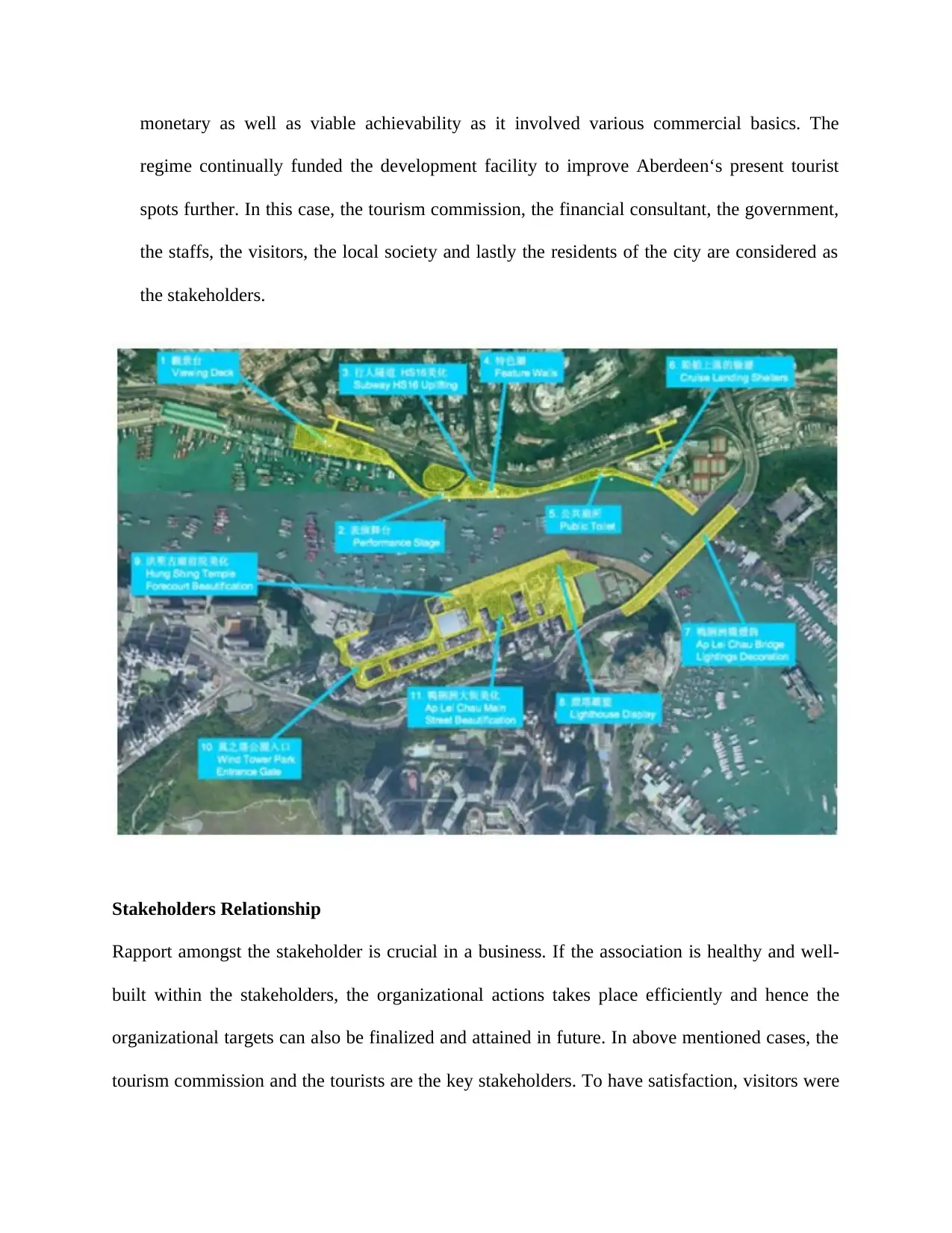
monetary as well as viable achievability as it involved various commercial basics. The
regime continually funded the development facility to improve Aberdeen‘s present tourist
spots further. In this case, the tourism commission, the financial consultant, the government,
the staffs, the visitors, the local society and lastly the residents of the city are considered as
the stakeholders.
Stakeholders Relationship
Rapport amongst the stakeholder is crucial in a business. If the association is healthy and well-
built within the stakeholders, the organizational actions takes place efficiently and hence the
organizational targets can also be finalized and attained in future. In above mentioned cases, the
tourism commission and the tourists are the key stakeholders. To have satisfaction, visitors were
regime continually funded the development facility to improve Aberdeen‘s present tourist
spots further. In this case, the tourism commission, the financial consultant, the government,
the staffs, the visitors, the local society and lastly the residents of the city are considered as
the stakeholders.
Stakeholders Relationship
Rapport amongst the stakeholder is crucial in a business. If the association is healthy and well-
built within the stakeholders, the organizational actions takes place efficiently and hence the
organizational targets can also be finalized and attained in future. In above mentioned cases, the
tourism commission and the tourists are the key stakeholders. To have satisfaction, visitors were
Paraphrase This Document
Need a fresh take? Get an instant paraphrase of this document with our AI Paraphraser
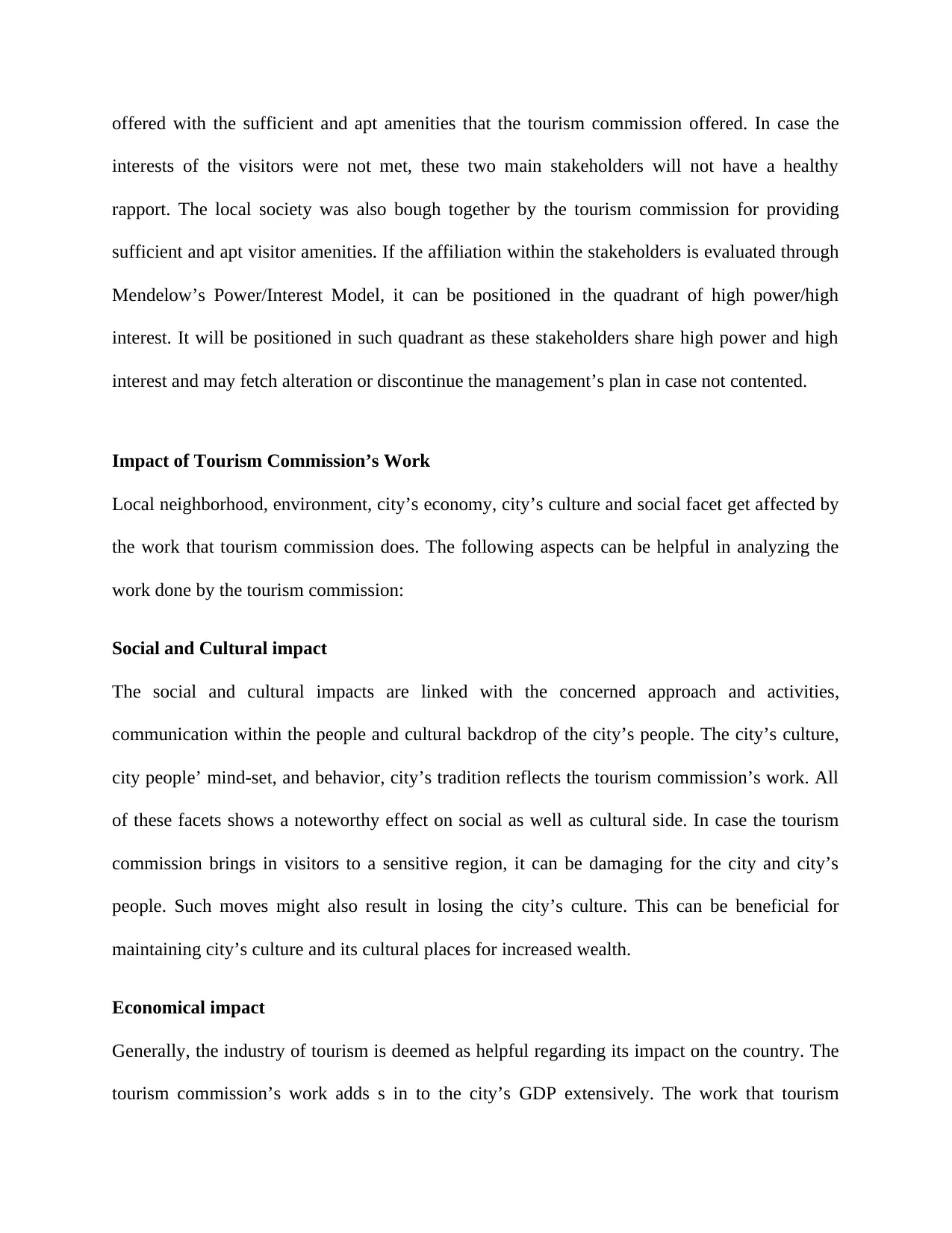
offered with the sufficient and apt amenities that the tourism commission offered. In case the
interests of the visitors were not met, these two main stakeholders will not have a healthy
rapport. The local society was also bough together by the tourism commission for providing
sufficient and apt visitor amenities. If the affiliation within the stakeholders is evaluated through
Mendelow’s Power/Interest Model, it can be positioned in the quadrant of high power/high
interest. It will be positioned in such quadrant as these stakeholders share high power and high
interest and may fetch alteration or discontinue the management’s plan in case not contented.
Impact of Tourism Commission’s Work
Local neighborhood, environment, city’s economy, city’s culture and social facet get affected by
the work that tourism commission does. The following aspects can be helpful in analyzing the
work done by the tourism commission:
Social and Cultural impact
The social and cultural impacts are linked with the concerned approach and activities,
communication within the people and cultural backdrop of the city’s people. The city’s culture,
city people’ mind-set, and behavior, city’s tradition reflects the tourism commission’s work. All
of these facets shows a noteworthy effect on social as well as cultural side. In case the tourism
commission brings in visitors to a sensitive region, it can be damaging for the city and city’s
people. Such moves might also result in losing the city’s culture. This can be beneficial for
maintaining city’s culture and its cultural places for increased wealth.
Economical impact
Generally, the industry of tourism is deemed as helpful regarding its impact on the country. The
tourism commission’s work adds s in to the city’s GDP extensively. The work that tourism
interests of the visitors were not met, these two main stakeholders will not have a healthy
rapport. The local society was also bough together by the tourism commission for providing
sufficient and apt visitor amenities. If the affiliation within the stakeholders is evaluated through
Mendelow’s Power/Interest Model, it can be positioned in the quadrant of high power/high
interest. It will be positioned in such quadrant as these stakeholders share high power and high
interest and may fetch alteration or discontinue the management’s plan in case not contented.
Impact of Tourism Commission’s Work
Local neighborhood, environment, city’s economy, city’s culture and social facet get affected by
the work that tourism commission does. The following aspects can be helpful in analyzing the
work done by the tourism commission:
Social and Cultural impact
The social and cultural impacts are linked with the concerned approach and activities,
communication within the people and cultural backdrop of the city’s people. The city’s culture,
city people’ mind-set, and behavior, city’s tradition reflects the tourism commission’s work. All
of these facets shows a noteworthy effect on social as well as cultural side. In case the tourism
commission brings in visitors to a sensitive region, it can be damaging for the city and city’s
people. Such moves might also result in losing the city’s culture. This can be beneficial for
maintaining city’s culture and its cultural places for increased wealth.
Economical impact
Generally, the industry of tourism is deemed as helpful regarding its impact on the country. The
tourism commission’s work adds s in to the city’s GDP extensively. The work that tourism
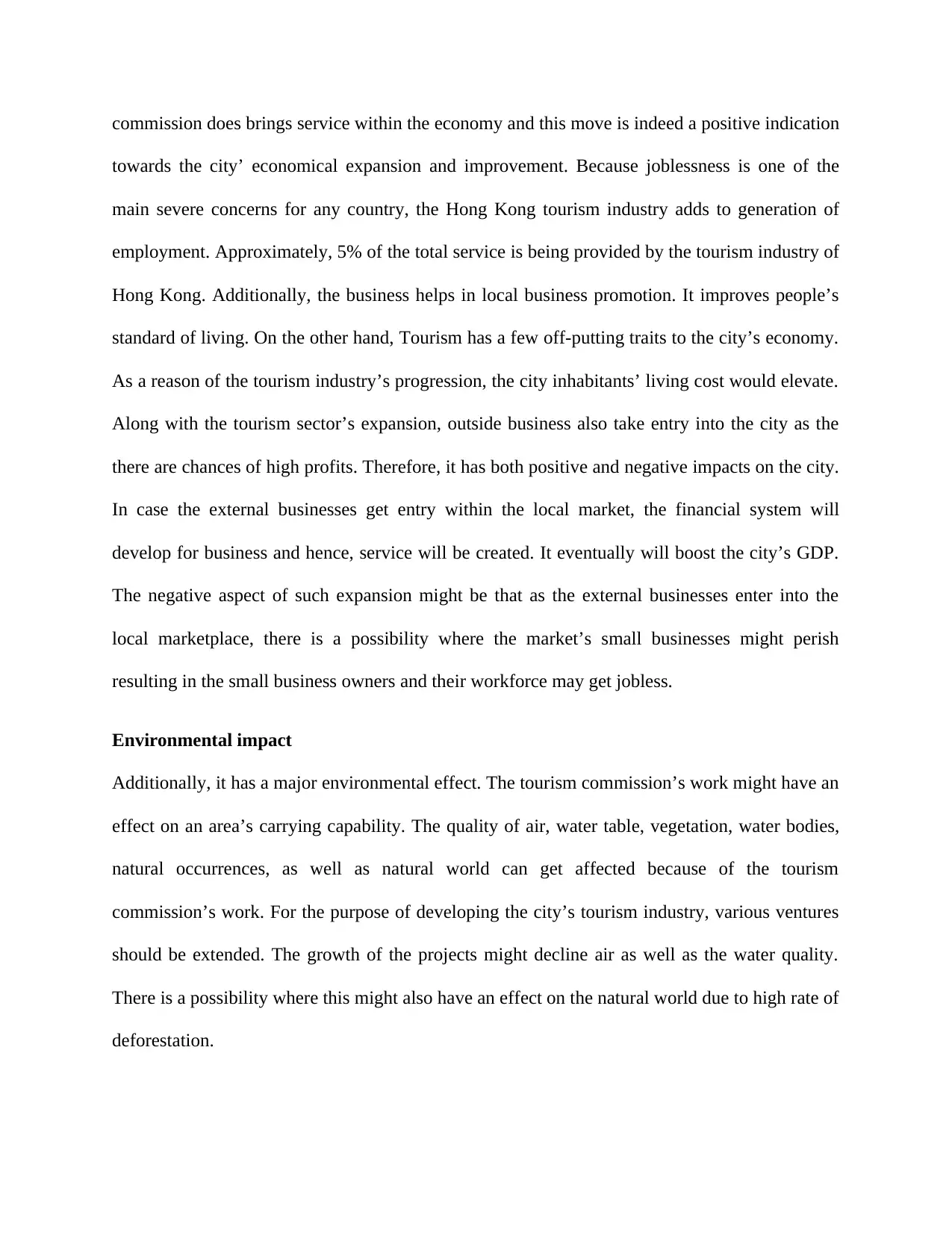
commission does brings service within the economy and this move is indeed a positive indication
towards the city’ economical expansion and improvement. Because joblessness is one of the
main severe concerns for any country, the Hong Kong tourism industry adds to generation of
employment. Approximately, 5% of the total service is being provided by the tourism industry of
Hong Kong. Additionally, the business helps in local business promotion. It improves people’s
standard of living. On the other hand, Tourism has a few off-putting traits to the city’s economy.
As a reason of the tourism industry’s progression, the city inhabitants’ living cost would elevate.
Along with the tourism sector’s expansion, outside business also take entry into the city as the
there are chances of high profits. Therefore, it has both positive and negative impacts on the city.
In case the external businesses get entry within the local market, the financial system will
develop for business and hence, service will be created. It eventually will boost the city’s GDP.
The negative aspect of such expansion might be that as the external businesses enter into the
local marketplace, there is a possibility where the market’s small businesses might perish
resulting in the small business owners and their workforce may get jobless.
Environmental impact
Additionally, it has a major environmental effect. The tourism commission’s work might have an
effect on an area’s carrying capability. The quality of air, water table, vegetation, water bodies,
natural occurrences, as well as natural world can get affected because of the tourism
commission’s work. For the purpose of developing the city’s tourism industry, various ventures
should be extended. The growth of the projects might decline air as well as the water quality.
There is a possibility where this might also have an effect on the natural world due to high rate of
deforestation.
towards the city’ economical expansion and improvement. Because joblessness is one of the
main severe concerns for any country, the Hong Kong tourism industry adds to generation of
employment. Approximately, 5% of the total service is being provided by the tourism industry of
Hong Kong. Additionally, the business helps in local business promotion. It improves people’s
standard of living. On the other hand, Tourism has a few off-putting traits to the city’s economy.
As a reason of the tourism industry’s progression, the city inhabitants’ living cost would elevate.
Along with the tourism sector’s expansion, outside business also take entry into the city as the
there are chances of high profits. Therefore, it has both positive and negative impacts on the city.
In case the external businesses get entry within the local market, the financial system will
develop for business and hence, service will be created. It eventually will boost the city’s GDP.
The negative aspect of such expansion might be that as the external businesses enter into the
local marketplace, there is a possibility where the market’s small businesses might perish
resulting in the small business owners and their workforce may get jobless.
Environmental impact
Additionally, it has a major environmental effect. The tourism commission’s work might have an
effect on an area’s carrying capability. The quality of air, water table, vegetation, water bodies,
natural occurrences, as well as natural world can get affected because of the tourism
commission’s work. For the purpose of developing the city’s tourism industry, various ventures
should be extended. The growth of the projects might decline air as well as the water quality.
There is a possibility where this might also have an effect on the natural world due to high rate of
deforestation.
⊘ This is a preview!⊘
Do you want full access?
Subscribe today to unlock all pages.

Trusted by 1+ million students worldwide

The Historic Buildings – Pro’s and Con’s
There are plentiful of advantages in case of utilizing the historic constructions, however a few
disadvantages are also there.
Pro’s associated with usage of historic buildings
One of the fundamental components of city resurrection efforts is the conservation of heritage
buildings. The advantages of utilizing historic building may be classified into a number of
groups like financial advantages, financial sustainability, as well as energy saving benefits, labor,
environment friendly- less dissipate, and other advantages.
The economic advantages are benefits gained through business from staying within a heritage
building. In case, businesses are settled within the heritage building, it will be helpful for the
business in generating further income as heritage buildings draw more tourists. It will also help
in raising the employment rate. It progressively helps in growing tourism. Once the tourism
further enhances, tourist comes for visiting and therefore the government eventually generates
more profits. This also advances base of the municipal tax by restored buildings.
The historic buildings create more service in comparison to new constructions. The historic
buildings are way more labor-demanding than the newly constructed buildings. It recruits more
effort in opposition to the machine and consequently boosts the employment rate. Very less
enery is used by the historic buildings than the new ones. Additionally, least amount of waste is
being produced by the historic building vs. the new buildings. This also facilitates in supporting
the progress of present infrastructure and prevents worsening.
It is already proved that the historic building saves energy. The energy needed for operating a
historic construction for 40 years is equal to the energy needed for establishing a new building. It
There are plentiful of advantages in case of utilizing the historic constructions, however a few
disadvantages are also there.
Pro’s associated with usage of historic buildings
One of the fundamental components of city resurrection efforts is the conservation of heritage
buildings. The advantages of utilizing historic building may be classified into a number of
groups like financial advantages, financial sustainability, as well as energy saving benefits, labor,
environment friendly- less dissipate, and other advantages.
The economic advantages are benefits gained through business from staying within a heritage
building. In case, businesses are settled within the heritage building, it will be helpful for the
business in generating further income as heritage buildings draw more tourists. It will also help
in raising the employment rate. It progressively helps in growing tourism. Once the tourism
further enhances, tourist comes for visiting and therefore the government eventually generates
more profits. This also advances base of the municipal tax by restored buildings.
The historic buildings create more service in comparison to new constructions. The historic
buildings are way more labor-demanding than the newly constructed buildings. It recruits more
effort in opposition to the machine and consequently boosts the employment rate. Very less
enery is used by the historic buildings than the new ones. Additionally, least amount of waste is
being produced by the historic building vs. the new buildings. This also facilitates in supporting
the progress of present infrastructure and prevents worsening.
It is already proved that the historic building saves energy. The energy needed for operating a
historic construction for 40 years is equal to the energy needed for establishing a new building. It
Paraphrase This Document
Need a fresh take? Get an instant paraphrase of this document with our AI Paraphraser
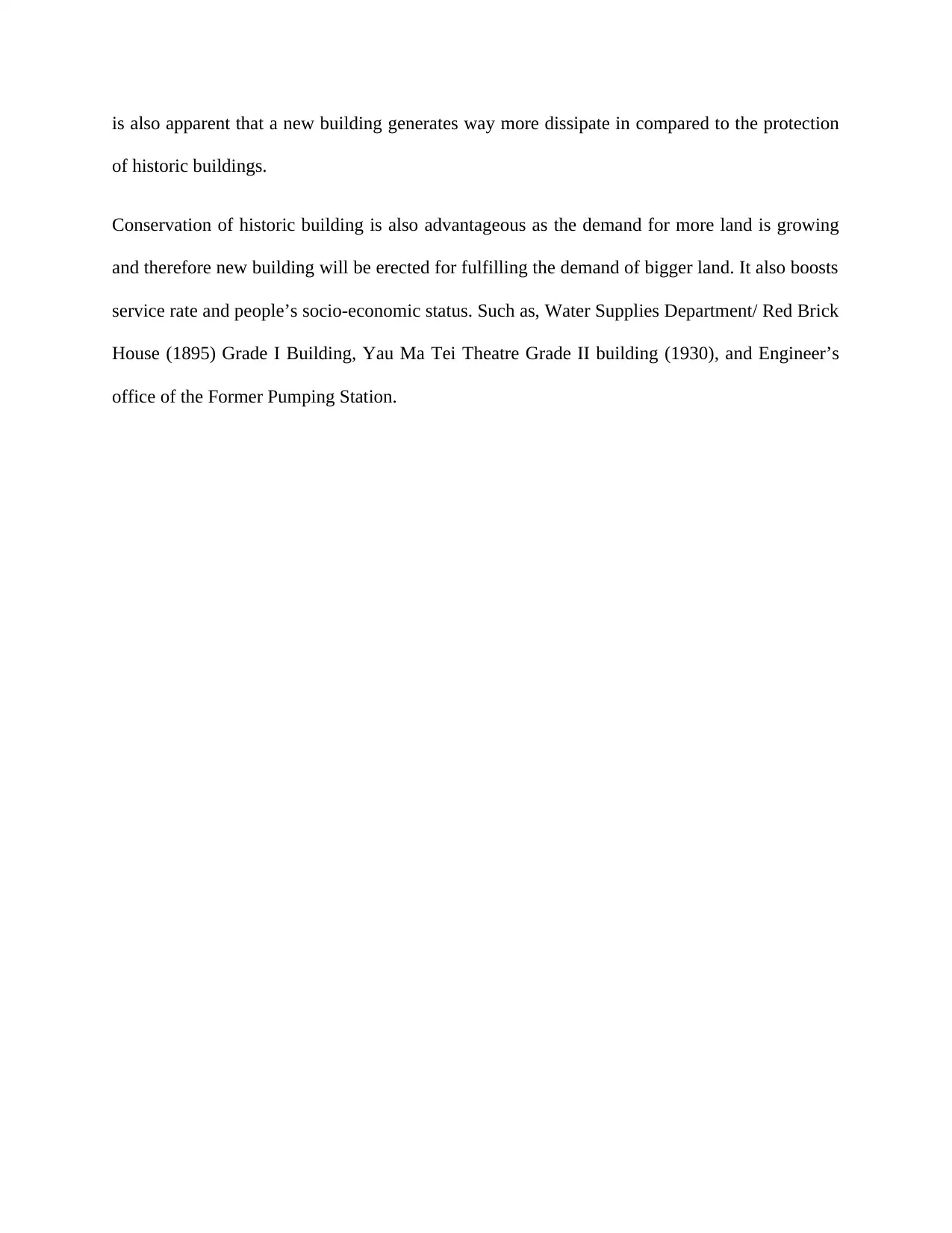
is also apparent that a new building generates way more dissipate in compared to the protection
of historic buildings.
Conservation of historic building is also advantageous as the demand for more land is growing
and therefore new building will be erected for fulfilling the demand of bigger land. It also boosts
service rate and people’s socio-economic status. Such as, Water Supplies Department/ Red Brick
House (1895) Grade I Building, Yau Ma Tei Theatre Grade II building (1930), and Engineer’s
office of the Former Pumping Station.
of historic buildings.
Conservation of historic building is also advantageous as the demand for more land is growing
and therefore new building will be erected for fulfilling the demand of bigger land. It also boosts
service rate and people’s socio-economic status. Such as, Water Supplies Department/ Red Brick
House (1895) Grade I Building, Yau Ma Tei Theatre Grade II building (1930), and Engineer’s
office of the Former Pumping Station.
1 out of 11
Related Documents
Your All-in-One AI-Powered Toolkit for Academic Success.
+13062052269
info@desklib.com
Available 24*7 on WhatsApp / Email
![[object Object]](/_next/static/media/star-bottom.7253800d.svg)
Unlock your academic potential
Copyright © 2020–2025 A2Z Services. All Rights Reserved. Developed and managed by ZUCOL.





